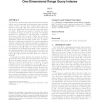Free Online Productivity Tools
i2Speak
i2Symbol
i2OCR
iTex2Img
iWeb2Print
iWeb2Shot
i2Type
iPdf2Split
iPdf2Merge
i2Bopomofo
i2Arabic
i2Style
i2Image
i2PDF
iLatex2Rtf
Sci2ools
PODS
2009
ACM
2009
ACM
Dynamic indexability and lower bounds for dynamic one-dimensional range query indexes
The B-tree is a fundamental external index structure that is widely used for answering one-dimensional range reporting queries. Given a set of N keys, a range query can be answered in O(logB N M + K B ) I/Os, where B is the disk block size, K the output size, and M the size of the main memory buffer. When keys are inserted or deleted, the B-tree is updated in O(logB N) I/Os, if we require the resulting changes to be committed to disk right away. Otherwise, the memory buffer can be used to buffer the recent updates, and changes can be written to disk in batches, which significantly lowers the amortized update cost. A systematic way of batching up updates is to use the logarithmic method, combined with fractional cascading, resulting in a dynamic B-tree that supports insertions in O( 1 B log N M ) I/Os and queries in O(log N M + K B ) I/Os. Such bounds have also been matched by several known dynamic B-tree variants in the database literature. Note that, however, the query cost of these ...
| Added | 25 Nov 2009 |
| Updated | 25 Nov 2009 |
| Type | Conference |
| Year | 2009 |
| Where | PODS |
| Authors | Ke Yi |
Comments (0)

